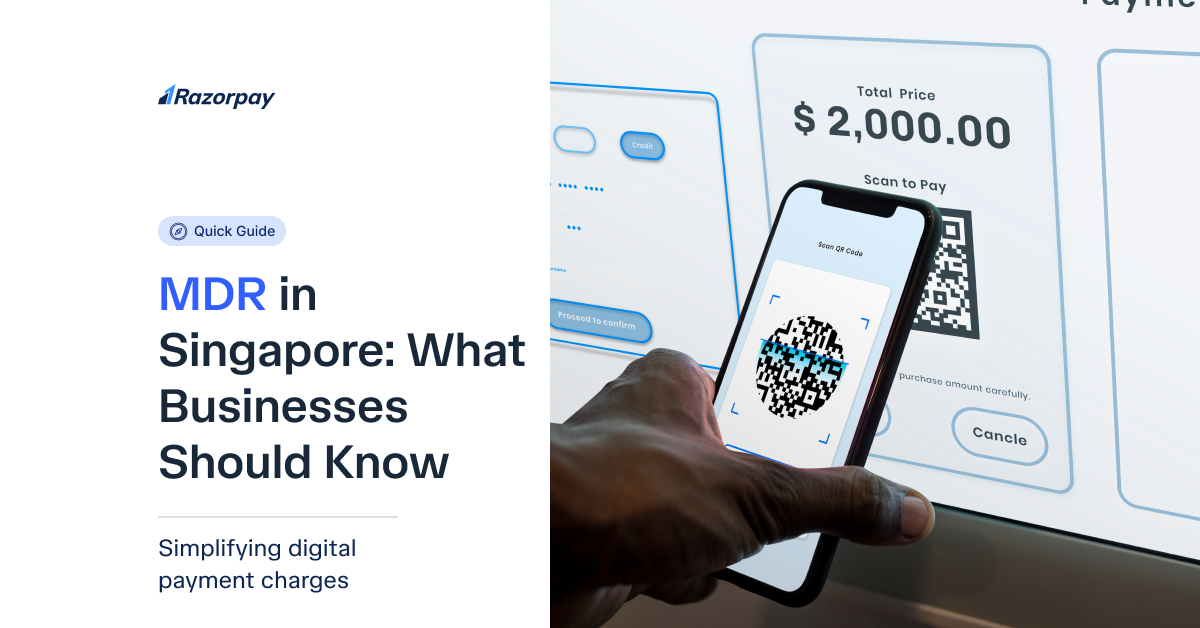For any business in Singapore, accepting card or e-wallet payments, the numbers on a sales report rarely match the final deposit. That gap is largely due to a crucial but often misunderstood fee: the Merchant Discount Rate (MDR).
As part of Singapore’s push towards a cashless society under its Smart Nation initiative, accepting digital payments is no longer a choice but a necessity. While MDR is a standard cost of doing business in this digital economy, it shouldn’t be a mystery. Understanding what it is, how it’s calculated, and what factors influence it is essential for any business owner looking to accurately forecast revenue, manage costs, and optimize profitability. An unexamined MDR is a hidden drain on your margins.
This in-depth guide provides a clear, straightforward breakdown of the Merchant Discount Rate for Singaporean businesses. We’ll demystify its components, explain why your rate isn’t fixed, and show how partnering with the right payment platform can transform this cost into a manageable part of your growth strategy.
Key Takeaways
- What MDR Is: The Merchant Discount Rate is a fee a business pays to its payment processor for each electronic transaction it accepts, charged as a percentage of the sale value.
- Core Components: MDR is not a single charge but a bundle of three main fees: the Interchange Fee (paid to the customer’s bank like DBS or UOB), the Card Scheme Fee (paid to Visa, Mastercard, etc.), and the Acquirer’s Markup (paid to your payment platform).
- Why Rates Vary: Your MDR is dynamic. It is influenced by factors like the customer’s payment method (premium credit cards cost more to process than basic debit cards), your business industry risk profile, and your total transaction volume.
- Cost vs. Benefit: While MDR is a cost, the benefits of accepting e-payments—such as increased sales, improved customer convenience, enhanced security, and reduced cash handling costs—far outweigh the expense in Singapore’s digital-first market.
What is the Merchant Discount Rate (MDR)? A Clear Definition
The Merchant Discount Rate is the fee your business pays for the convenience and security of processing a customer’s card or e-wallet payment. It is almost always calculated as a percentage of each transaction’s total value.
Business Example: A customer buys a product from your online store for S$100 and pays with their credit card. If your MDR is 2.7%, the fee for that transaction would be S$2.70. The remaining S$97.30 is the amount that will be settled to your business bank account.
This fee covers the entire ecosystem of banks and technology providers required to make a digital payment happen instantly and securely.
Breaking Down the Three Core Components of MDR
The MDR you pay is not a single fee. It is a combination of three distinct charges that are bundled together.
1. The Interchange Fee: The Cost of Issuing the Card
This is the largest portion of the MDR, typically making up 70-80% of the total fee. It is a fee that your payment processor collects from you and pays to the customer’s card-issuing bank (e.g., DBS, UOB, OCBC).
- Purpose: It compensates the issuing bank for the costs and risks it undertakes. This includes the risk of fraud, the cost of funding the interest-free credit period for the consumer, and the expense of running rewards programs (like miles or cashback). This is why a premium rewards card has a higher interchange fee than a no-frills debit card.
- Who sets it: Interchange fees are set by the card networks (Visa, Mastercard) and are non-negotiable for individual businesses.
2. The Card Scheme Fee: The Price for Using the Network
This is a smaller fee paid directly to the card network itself (e.g., Visa, Mastercard, American Express).
- Purpose: It covers the card scheme’s costs for operating, maintaining, and securing their vast global payment networks, which connect millions of merchants with thousands of banks.
- Who sets it: This fee is also set by the card networks.
3. The Acquirer’s Markup: The Fee for Processing and Service
This is the only component of the MDR that is charged by your direct payment partner—your acquiring bank or a modern payment platform like Razorpay Singapore.
- Purpose: This markup covers the provider’s operational costs, including their technology infrastructure, security and PCI DSS compliance, advanced fraud detection systems, reconciliation tools, customer support, and their profit margin.
- Who sets it: This fee is determined by your payment platform. Because platforms like ours process enormous transaction volumes, we benefit from economies of scale and can often offer a more competitive markup than a traditional acquirer.
Why Your MDR Varies: Key Factors That Influence Your Rate
Your MDR isn’t a one-size-fits-all rate. Several factors determine the final percentage you pay.
- Payment Method: Different cards carry different levels of risk and rewards. A premium rewards credit card has a higher interchange fee than a basic debit card. Transactions via digital wallets may also have a different fee structure.
- Business Model and Industry Risk: Industries with a higher historical rate of chargebacks (e.g., travel, ticketing, digital services) are considered higher risk. This increased risk is reflected in a higher MDR. A physical retail store, in contrast, is typically considered lower risk.
- Transaction Volume: Businesses with a higher volume of monthly transactions often have the leverage to secure a lower acquirer’s markup. Payment platforms can also negotiate better rates from card schemes by pooling the volume of all their merchants.
- Transaction Type: “Card-Not-Present” (CNP) transactions, like those online, are considered higher risk than “Card-Present” (CP) transactions, where a card is physically tapped or swiped. This is because CNP fraud is more common, which can lead to slightly higher rates.
Did You Know?
Low-cost payment methods are disrupting the traditional MDR model in Singapore. For instance, PayNow transactions typically have a very low, fixed fee instead of a percentage-based MDR.
This is because they are direct bank-to-bank transfers and bypass the card network ecosystem entirely. Offering PayNow alongside cards can be a smart strategy to lower overall payment processing costs.
Conclusion
The Merchant Discount Rate is an integral cost of participating in the digital economy. But by understanding its components and the factors that influence it, you can move from passively accepting it to actively managing it. Partnering with a modern payment platform is the most effective way to ensure you’re not just getting a good rate, but also a secure, efficient, and transparent system that supports your business’s growth in the Singaporean market.
Power Your Business with Razorpay Singapore
Start accepting payments with a platform built for growth. Fast, secure, and reliable solutions for businesses of all sizes.
Frequently Asked Questions (FAQs)
Why is the MDR for American Express often different from Visa or Mastercard?
American Express operates on a different model. While Visa and Mastercard are open networks connecting thousands of banks, Amex often acts as the card issuer, the acquirer, and the network all in one. This “closed-loop” system gives them more control over their fee structure, which can sometimes result in a different MDR.
Can I avoid MDR by only accepting cash?
While technically possible, a “cash-only” strategy in a market as digitally advanced as Singapore can severely limit your sales potential. You risk losing customers who prefer the convenience and security of e-payments. Furthermore, the hidden costs of handling cash (security, transport, time spent on reconciliation) are often higher than the MDR itself.
What is the difference between MDR and a transaction fee?
MDR is a specific type of transaction fee that applies to card and e-wallet payments and is calculated as a percentage. “Transaction fee” is a broader term that can also refer to flat fees, such as the small, fixed cost that might apply to a PayNow or direct debit transaction.
How can I lower my business’s MDR?
The most effective strategies are to increase your total processing volume, as this gives you more negotiating power, and to partner with a payment platform that can offer competitive blended rates. Additionally, encouraging customers to use lower-cost methods like PayNow where appropriate can help reduce your overall average cost per transaction.




